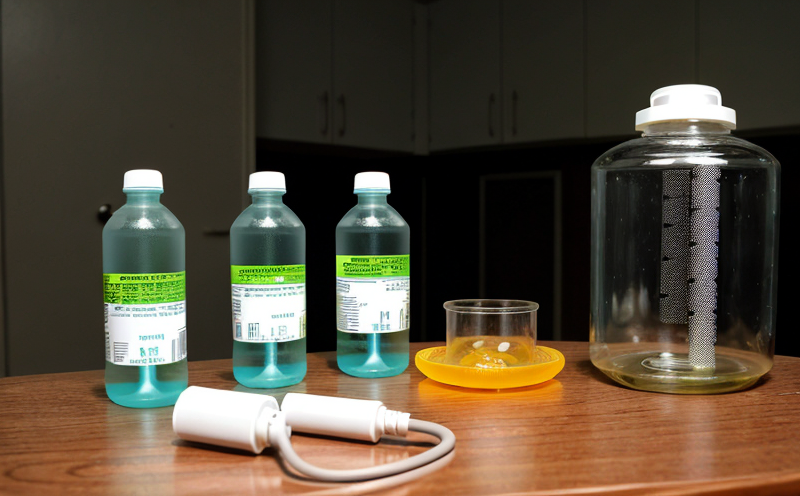EPA 928 Neptunium 237 Determination Test in Water
The determination of neptunium-237 (Np-237) in water is a critical analytical challenge, especially given the radioactive and toxic nature of this actinide. The Environmental Protection Agency's Method 928 outlines a comprehensive procedure for the quantification of Np-237 in aqueous samples. This method is essential for ensuring compliance with environmental regulations aimed at protecting public health and the environment.
Neptunium, found naturally as a byproduct of uranium enrichment processes, can accumulate in water supplies through various pathways. Given its high toxicity and long half-life (2.1 million years), accurate measurement is paramount for regulatory compliance and environmental protection. The EPA 928 method provides a robust framework to achieve this.
The first step in the testing process involves sample preparation, which includes dilution of the water samples if necessary to bring them within the detection range of the analytical instruments used. This ensures that the concentrations are suitable for accurate measurement without compromising the integrity or accuracy of the results.
Following sample preparation, the actual analysis proceeds using a combination of techniques aimed at isolating and quantifying Np-237. Typically, this involves a series of chemical separations to isolate actinides from other elements present in the water. The method then utilizes a high-resolution gamma spectrometry system for detection.
The EPA 928 protocol specifies stringent quality control measures and calibration procedures to ensure that results are accurate and reproducible. This includes the use of certified reference materials (CRMs) to calibrate instruments and validate methods. The method also emphasizes the importance of interlaboratory comparisons, which help maintain consistency across different testing facilities.
Interpretation of results is critical in this context, as even minute quantities of Np-237 can have significant implications for public health and environmental safety. The protocol provides detailed guidelines on how to interpret the data obtained from the analysis, ensuring that stakeholders are provided with clear and actionable information.
The EPA 928 method is not only a regulatory requirement but also an essential tool in the hands of R&D engineers working on water treatment technologies. By accurately measuring Np-237 levels, these engineers can refine processes to reduce contamination risks and enhance purification methods. For quality managers and compliance officers, this test ensures that facilities meet stringent environmental standards.
The method's precision is crucial for ensuring reliable results, and it is designed to achieve a detection limit of 0.1 pCi/L (picocuries per liter). This level of sensitivity underscores the importance of accurate measurement techniques and high-quality analytical equipment. The use of gamma spectrometry in this context also allows for simultaneous measurement of other actinides, providing additional insights into water quality.
In summary, the EPA 928 Neptunium-237 Determination Test is a cornerstone of environmental safety and compliance efforts. Its rigorous protocols ensure that even small quantities of Np-237 are detected and reported accurately, contributing to the broader goal of protecting public health and the environment.
Benefits
The EPA 928 Neptunium-237 Determination Test offers several key benefits:
Regulatory Compliance: Ensures that water treatment facilities meet stringent environmental regulations set by the Environmental Protection Agency.
Precision and Accuracy: The method provides precise quantification of neptunium-237, which is critical for accurate reporting and decision-making.
Risk Reduction: By identifying even small quantities of Np-237, the test helps reduce risks associated with contamination and exposure to this toxic actinide.
Informed Decision-Making: Results from this test can inform R&D initiatives aimed at improving water treatment processes and reducing contamination risks.
Interlaboratory Consistency: The method supports consistent results across different testing facilities through stringent quality control measures and interlaboratory comparisons.
Certified Reference Materials: Utilization of CRMs ensures that analytical instruments are properly calibrated, leading to reliable and reproducible results.
Quality and Reliability Assurance
The EPA 928 Neptunium-237 Determination Test places a strong emphasis on quality and reliability assurance. The method specifies detailed protocols for sample preparation, calibration of analytical instruments, and data interpretation to ensure that results are accurate and reliable.
Sample Preparation: Dilution of samples is performed as necessary to bring them within the detection range of the gamma spectrometry system used in the analysis. This step ensures that the concentrations are suitable for accurate measurement without compromising the integrity or accuracy of the results.
Calibration and Standardization: The method requires the use of certified reference materials (CRMs) to calibrate analytical instruments. This step is critical to ensure that all testing facilities achieve consistent and reliable results. CRMs provide a known standard against which test results can be compared, ensuring accuracy.
Data Interpretation: The protocol provides detailed guidelines on how to interpret the data obtained from the analysis. This ensures that stakeholders are provided with clear and actionable information, facilitating informed decision-making.
Interlaboratory Comparisons: To maintain consistency across different testing facilities, the method emphasizes the importance of interlaboratory comparisons. These comparisons help ensure that results obtained by different laboratories are consistent, reducing variability in test outcomes.
Quality Control Measures: The method specifies stringent quality control measures to ensure that all steps of the analysis are performed correctly and consistently. This includes regular checks of instrument performance and adherence to standard operating procedures.
Use Cases and Application Examples
The EPA 928 Neptunium-237 Determination Test finds application in a variety of sectors, including:
Water Treatment Plants: Ensures compliance with environmental regulations by accurately measuring Np-237 levels in water supplies.
R&D Facilities: Supports the development and optimization of water treatment technologies aimed at reducing contamination risks.
Regulatory Agencies: Provides reliable data for regulatory enforcement and compliance monitoring.
Environmental Monitoring: Assists in identifying areas with high concentrations of Np-237, allowing for targeted interventions to mitigate risks.
Industrial Plants: Ensures that industrial processes do not contribute to the contamination of water supplies with Np-237.
Public Health Authorities: Contributes to the protection of public health by identifying and addressing potential sources of exposure to this toxic actinide.
Research Institutions: Supports scientific research aimed at understanding the behavior of Np-237 in aquatic environments and its impacts on ecosystems.





